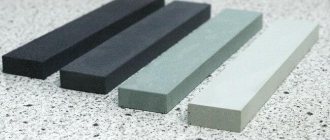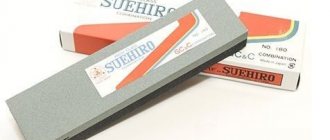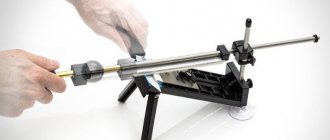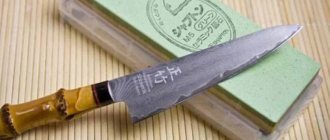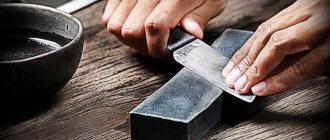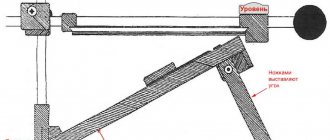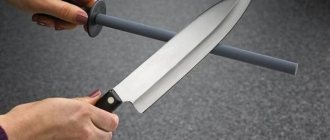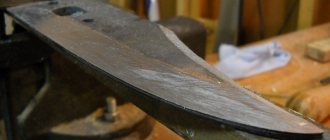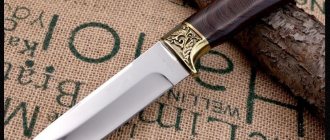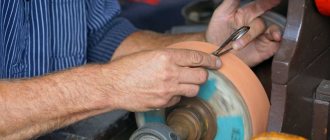Sharpening stones are multifunctional tools; they are needed for repairing, straightening and sharpening devices that have a cutting edge. They cope excellently with such tasks as sharpening, since the force and intensity of manual processing are selected independently, unlike electric machines, which operate at high speeds and, due to a small mistake, can ruin the entire product. Another advantage of the bars will be their modest dimensions, thanks to which any tourist, fisherman or hunter can have them with them.
Stones for sharpening knives.
Classifications of whetstones
The first sharpening stones were used by humans in ancient times. For example, to restore the cutting properties of their scythes, peasants used special bars called whetstones.
The sharpening stone acquired a more or less modern appearance during the Soviet era, when special markings began to be applied to it. This was forced by adjusting all manufactured products to general standards.
The bars of that time had the following data:
- manufacturer's mark;
- product type;
- dimensions;
- grain;
- material of manufacture;
- technical properties;
- accuracy class;
- GOST standard.
According to their type of origin, sharpening stones are divided into 2 groups:
- natural;
- artificial.
Natural whetstones
Mines of natural abrasives can be found in Belgium, Germany, Turkey, Japan, and the USA.
Made from Arkansas stone
Novaculite from Arkansas has become widespread. It is a homogeneous white mineral with a yellowish or bluish tint. The peculiarity of quartz lies in its structure: it consists of 99.5% silicon oxide.
The formation conditions of the layers determined the characteristics and dimensions of the material and made it possible to distinguish the following types of fractions: hard, medium, soft. The main type of novaculite has a fine-grained structure within 1-6 microns, with each fraction resembling a tooth and their boundaries growing into each other, forming a durable grinding coating.
Arkansas stone knife sharpener.
Varieties of Arkansas abrasive are characterized by lower hardness, which is explained by larger grains and greater porosity of the minerals.
During mining, washita stone is often found to be black, brown or gray in color. It is inferior in strength to soft Arkansas, but remains in demand due to its low price.
Made from Japanese water stone
Japanese water stones, which have been mined in the vicinity of Kyoto for several centuries, are also used to make natural sharpening stones. Their main advantage is the fast, soft sharpening of the tool to razor sharpness.
Before use, the products are soaked in water for 5-30 minutes until air bubbles stop escaping from them. This is necessary to ensure that the pores of the instrument do not become clogged with metal dust. Coarse-grained stones for sharpening knives are soaked for 5 minutes, fine-grained stones should be kept in water for at least 15 minutes.
The disadvantages of abrasive include:
- high cost;
- the need for constant lubrication;
- quick grinding, requiring regular alignment.
Sandpaper is placed on a plate of marble or glass, and then they begin to carefully grind down the stone.
Synthetic stones
Artificial whetstones for sharpening knives are made from particles of silicon carbide or electrocorundum, soldered to a binder material by applying pressure and high temperatures. Among other types of whetstones, they stand out for their low price and availability, but they quickly wear out.
Bars made of synthetic water stone.
The combination of grain calibration and binder quality serves as an indicator of product reliability. Inexpensive grinding models have a non-uniform grain surface and low quality binder, so they quickly lose their appearance, requiring frequent leveling.
Tools with a medium grain grind down slowly, samples with a fine-grained structure practically do not wear out, but are quickly covered with metal particles. Therefore, after polishing, such stones are rinsed with soapy water.
Water stones of synthetic origin are obtained from carbides and oxides of silicon, chromium, and aluminum. The main requirement for their manufacturing technology remains careful sifting of the basic elements. The content of particles of different sizes in the structure affects the quality of sharpening stones.
Ceramic or bakelite elements are used as a binder, which differ in the degree of hardness of the finished product.
The use of expensive raw materials increases the cost of water-based abrasives. It is higher than that of artificial analogues, but lower than that of natural instruments.
Diamond bars
The products are complete analogues of stones; they have different configurations and grain sizes, which makes them possible to use in various everyday situations. Most often, diamond stones are sold on stands or in the form of narrow bars.
Diamond bars have different configurations and sizes.
The main advantage is the high sharpening speed, so during processing you can use special holders that will not allow you to damage the knife. In order to make the blade sharper, the knife is ground again with an abrasive made of a different material.
The high efficiency of coated sharpening stones makes it possible to reduce the length of the product by 1.5 times, which explains the demand for pocket diamond sharpeners.
The surface of the whetstone for knives wears out slowly, and even the fragment that has lost its abrasive properties remains flat.
Ceramic bars
The products combine the advantages of natural abrasives and the strength of diamond bars. They are made from a material that has much in common with ceramics for microcircuits. Most often, these types of stones are used only for editing and finishing knives. They are not wetted during operation, but after use they are immersed in water for rinsing. The shape of ceramic stones allows you to sharpen not only knives, but also fishing gear (needles, hooks).
Japanese water stones
Japanese stones of natural origin have been recognized throughout the world for quite some time; moreover, they have the status of stones that occupy one of the first positions in their class. For many years, these stones, especially those mined near quarries located near Kyoto, have been an object of desire. This is explained by the fact that the materials mentioned have incomparable abrasive characteristics.
In the area around Kyoto you can find a huge number of quarries that produce excellent sharpening stones, but in terms of cost and quality characteristics, all stones can be divided into two large groups, the first of which is Oriental things, which is translated into Japanese as 東物; and Western things, translated into Japanese - 西物. At the same time, Eastern materials have a much higher cost, in addition, they are more valuable and respected. The group of Oriental stones includes some varieties, including: Nakayama, Oozuku, Narutaki, Shoubudani, Okudo. If we compare the named stones, then Nakayama has great fame among the others.
Grit of sharpening stones
It should be noted right away that even amateur sharpening on stones is far from simple. Those who have never used such abrasives may encounter certain difficulties at the very beginning of their journey - choosing a “tool”. What grit size of stone is needed for sharpening knives? Let's try to fully cover this topic, putting everything into detail.
The very first question, the answer to which will help you choose the right stone for knives, concerns the grain size, it is also called grit. The aggressiveness of the impact on the metal directly depends on the value of this parameter.
Large grains leave deep chips and gouges on the surface, which is unacceptable. An ideal job is considered to be a smooth, sharp, mirror-like cutting edge without any defects. That is why large grains are used only for working with workpieces, that is, processing a newly forged blade, or for restoration. Fine grains are responsible for grinding and final polishing. True, working with this stone takes an order of magnitude longer, but the result is worth it. Medium grain sharpens if the blade is slightly dull.
In your kit, it is advisable to have a minimum, if you sharpen infrequently or are just learning, three double-sided stones: with very fine grain, medium and coarse. It is worth working, moving from large to small.
Water stones for sharpening knives of various grain sizes.
Grit and Roughness Table
This table contains all the necessary information that will help you understand the different types of stones: markings, grain size, roughness and purpose.
| Class | Average grain size, microns. | Grit | Russia | Purpose | ||
| Japan (watermen) | USA | Germany | GOST 9206-81 (diamonds) | |||
| 14 | 0,025 | — | — | 0,1/0 | Editing and polishing, super finish | |
| 14 | 0,05 | — | — | |||
| 13 | 0,07 | 200,000 | — | |||
| 13 | 0,1 | — | — | |||
| 12 | 0,15 | 100,000 | — | 0,3/0 | ||
| 12 | 0,25 | 60,000 | 100,000 | |||
| 11 | 0,49 | 30,000 | 60,000 | 1/0,5 | ||
| 10 | 0,74 | 20,000 | 20,000 | |||
| 10 | 0,91 | 16,000 | 16,000 | |||
| 9 | 1 | 15,000 | 14,000 | 1/0 | ||
| 9 | 1,5 | 10,000 | 10,000 | 2/1 | ||
| 9 | 2 | 8,000 | — | F 1500 | ||
| 8 | 3 | 5,000 | 8,000 | F 1200 | 3/2 | |
| 7 | 5 | 3,000 | 4,500 | — | 5/3 | |
| 7 | 5,3 | — | — | — | 7/5 | |
| 7 | 7 | — | — | — | ||
| 7 | 8,5 | 1,800 | P 2500 | — | 10/7 | |
| 6 | 10 | 1,500 | — | F 600 | Removing grinding marks, fine sharpening and finishing | |
| 6 | 15 | 1,000 | P 1200 | — | 20/14 | |
| 6 | 18 | 800 | P 1000 | F 400 | ||
| 5 | 20 | — | — | — | ||
| 5 | 26 | 600 | P 600 | — | 28/20 | |
| 4 | 30 | 500 | P500 | F 320 | 40/28 | Removing traces of roughing operations, grinding |
| 4 | 35 | 400 | P 400 | — | ||
| 4 | 46 | 320 | P 320 | F 240 | 60/40 | |
| 3 | 53 | 280 | P 280 | F 230 | ||
| 3 | 68 | 240 | P 220 | F 180 | 80/63 | |
| 3 | 82 | — | P 180 | F 150 | ||
| 2 | 100 | — | P 150 | — | 125/100 | Roughing operations, intensive metal removal |
| 2 | 136 | 120 | — | — | — | |
| 1 | 260 | — | P 60 | F 60 | — | |
Practicing the sharpening angle
Learn the proper angles for the different types of knives you sharpen.
Most manufacturers recommend an angle of 20 degrees to the stone.
Use a smaller angle when working with coarse-grain stones than when working with medium- and fine-grain stones. A rough stone will remove more material from the blade, and you don't want the width of the knife to be reduced significantly. Fine and medium grit stones remove less material, so you can use them at a 20-degree angle.
Consider the size and strength of the knife. Thick knives used in the wild or when cutting meat require a greater angle to the whetstone than a small paring knife.
Practice taking the correct angle to the stone with your hand two to three dozen times. Learn that the best results are achieved with constant, identical movements - this way the cutting edge of the knife will come out perfect.
If you have trouble eyeballing the right angle, set the knife at a 45-degree angle (half of a 90-degree right angle), and then halve the angle again until you have about 20 degrees. Adjust if necessary.
Main criteria when choosing a stone
Before purchasing a tool you must:
- Select abrasive material. In everyday life, ceramic products are more often used, for example, a boat-shaped block. A double-sided sharpener with a rough and smooth surface is often found. Diamond stones are rarely used in professional sharpening of kitchen knives. The high price limits the spread of natural abrasives.
- Pay attention to graininess. When sharpening, use bars with a grain size of 600-800 units. To polish the edge, bars marked 1500-2000 are used. Bars with a grain size of more than 2000 are intended for professional work.
- Consider the scope of use. The size of the block should exceed the length of the blade by 1.5-2 times.
Diamond bars
Diamond bars can also have different degrees of grain size, so the material contains different fractions of diamond chips. Due to the fact that diamond is considered the hardest material, a diamond whetstone can be used to sharpen a knife in the shortest possible time. Diamond abrasive forms a fairly aggressive cutting edge, which has a second name - micro-saw, but it soon chips, which causes the cutting edge to become dull. While water stones with small abrasive grains form a much smoother edge base, it chips much more slowly. This ensures that the cutting edge does not become dull over a long period of operation. Single crystals and polycrystals, which are present in diamonds, are not as susceptible to chipping.
Conformity table for abrasive materials.
Stones for sharpening knives made in Russia
The list of popular Russian-made sharpening stones includes products from the following companies:
- "Gritalon". This brand produces synthetic products for electric sharpeners and manual sharpening. The base material for abrasives is silicon carbide.
- "Petrograd". The grain size of the manufactured stones complies with the Japanese standard JIS-2017.
- Grinderman. The production was launched in St. Petersburg under the leadership of Andrei Petrov. The company produces and sells sharpening stones and means for their maintenance.
Popular foreign brands include Metabo, Samura, YOSHIKIN, Dan's, Lansky.
Determine if a stone requires water
Read the instructions for the stone before you begin. It will tell you whether the stone needs to be lubricated with oil or water to start working. When working with sharpening stones, oil is used to remove small chips from the stone. The sharpening process produces fine metal filings. Your stone may not require any oil or water, as many modern sharpening stones do not.
Diamond stones and water stones require water for lubrication. Spray the surface of the stone with a small amount of water from a spray bottle.
With Indian and Arkansas stones, oil is typically used for lubrication. Cover the surface of the stone with a thin layer of oil by spraying it with a spray bottle.
Sharpening the knife
Place the whetstone on a stable table. It should be higher so that you can easily move your hand over the stone.
Place the knife on the surface of the stone. Adjust the required angle of contact between the knife and the stone, as described above. Make sure the stone is parallel to your body. The sharpening motion should be parallel to your body, not perpendicular to it.
Start at one edge of the stone. Make sure the entire edge of the blade is touching the stone.
Move the knife in an arc. This will allow you to sharpen all parts of the blade above the stone.
Repeat the strokes until burrs begin to appear on the opposite side. You may need 6 to 12 strokes for them to start appearing.
You can notice burrs by gently touching the opposite side of the knife's cutting edge. Be extremely careful when running the skin across the blade - this applies to all knives.
Sharpen the knife on the other side of the blade until burrs also appear.
Move to a fine-grained stone and repeat the entire process on both sides. Use a slightly larger angle. This will remove burrs and make the knife sharper.
If you started with a medium-grain stone, you may not notice any noticeable burrs. They are more noticeable when working with coarse-grained stone. Make the same number of strokes on each side of the knife.
Test the knife by cutting a piece of paper. Repeat the process if the knife is not sharp enough.
Clean the sharpening stones according to the manufacturer's instructions. This will remove any metal shavings for next use.
Recommendations for sharpening
High-quality sharpening of a knife with a whetstone is an entire art. For this reason, working with a block will require some preliminary preparation. First of all, it is necessary that the surface for sharpening is flat. You can check how flat it is by soaking the block in water and then placing it on a sheet of paper on a flat surface. If roughness is visible on the print, then you need to level the working surface by rubbing one block against another.
The knife to be sharpened should be positioned with the cutting edge facing away from you and moved forward along the working surface. It is important that the knife remains in the same position relative to the block; this feature is the key to successful sharpening. The angle at which the knife should be positioned should be from 15 to 45 degrees. This variability will allow you to achieve the best results. In any case, you need to practice and see how the chosen angle affects sharpening.
For primary sharpening, a stone with a large grain is used. If the blade is as dull as possible, this will give the blade a shape that will later be refined by using a fine-grained whetstone. The key to sharpening knives is practice.
